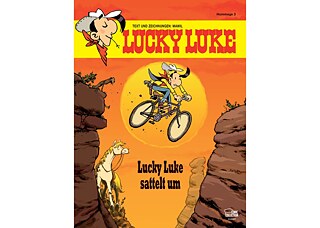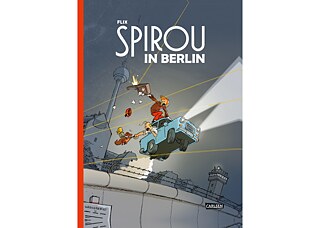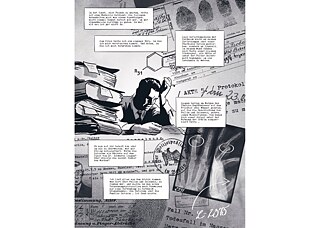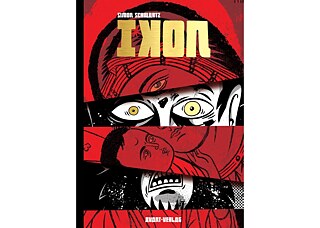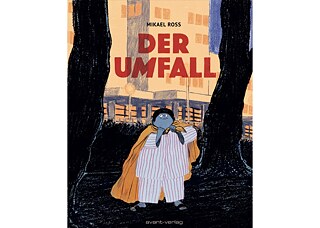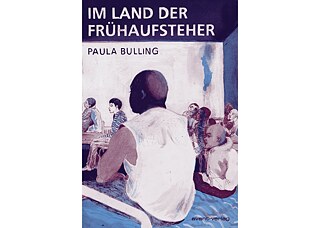2019 German Comic Scene
A fun take on history; a deep dive into the present

The number of new comic books published in Germany is rising – in large part thanks to a number of young artists jumping directly from the art academy straight into the book market. They are exploring everything from current socio-political topics to important historical figures.
By Ralph Trommer
The Berlin Wall is back, in a comic strip at least. Berlin cartoonist Flix, alias Felix Görmann, rebuilt it in Spirou in Berlin so the hero of the story could travel to late 1980s East Berlin. The album – which is what hardcover comic books are often called in Europe – ends with hints that the Wall may soon fall and Spirou has played his part. What makes this comic so unique is that Flix was the first German artist permitted to draw and re-interpret a Franco-Belgian comic icon, bellboy Spirou, who first hit the comic-book scene in 1938.
Shortly afterwards, fellow Berlin cartoonist Mawil (Markus Witzel) was also given the opportunity to reinterpret a Belgian comic classic and drafted a new adventure for popular Western hero Lucky Luke. Lucky Luke, who can draw his Colt faster than his shadow can, was invented by Morris (Maurice de Bévère) in 1946. Both German cartoonists have succeeded in creating loving tributes characterized by a wealth of allusions - to comic history, for example – that appeal to life-long fans of the series and new readers alike.
From the graphic novel to the manga
Today’s German comic scene is not defined by a uniform style or specific issue. There is an impressive diversity that encompasses very different genres and narrative forms. It includes everything imaginable: the socially critical graphic novel, biography, classic comic strip, manga, comic documentary, and quirky alternative narrative.
The growing number of new publications is striking. Many young artists, mostly fresh art school graduates, are publishing their debut works with houses like Jaja Verlag, Reprodukt, Rotopol and avant. In Hanno, Hanna Gressnich relies on deliberately minimalist lines to tell the touching story of an Indian elephant uprooted in the 16th century and resettled to Europe as a gift to the Pope. In Girlsplaining, Katja Klengel draws cheeky, self-ironic comic strips about the gender clichés she confronts every day in a loose, manga-influenced style.
With a comic book scholarship, cartoonist Mikael Ross was able to finance the work on his touching and atmospheric graphic novel Der Umfall (The Toppling). After extensive research in care institutions, he chronicled the story of Noel, a young man who lives with intellectual disabilities. Artist Paula Bulling explored and elucidated the problems of refugees in Saxony-Anhalt in Im Land der Frühaufsteher (In the Country of Early Risers) in her experimental, documentary narrative. In the current volume Lichtpause (Blueprint), she poetically sketches a day in Algiers in impressionistic panels executed with coloured pencils, drawing on her own observations during time spent in the country.
Travelling back in time
Many artists combine historically founded narratives with elaborate drawings, such as Arne Jysch with his adaptation of a crime novel by Volker Kutscher, Der nasse Fisch (The Wet Fish or The Cold Case). In his naturalistic ink drawings, he takes particular care to accurately depict 1920s Berlin. Newcomers Patrick Spät and Bea Davies take a similar approach in König der Vagabunden (King of the Vagabonds) towards Gregor Gog, founder of the “Brotherhood of the Vagabonds” artists collective and the Vagabond Congress in the Weimar Republic until he was targeted by the National Socialists. Like Jysch, illustrator Bea Davies works in black and white and painstakingly researches what the period was like and what clothes were worn.
After Packeis and Vita Obscura, cartoonist Simon Schwartz, whose graphic novel drüben! (Over there!) explores growing up in East Germany, focuses on another historical figure in his graphic novel Ikon: forgotten icon painter Gleb Botkin, who was a witness and survivor of the massacre of the Russian tsar family in July 1918 and later supported the “fake Anastasia”, Franziska Czenstkowski. In his most recent work The Parliament, Schwartz portrays selected German members of parliament since 1848, one on each page, pointedly and with subtle wit. The accompanying exhibition was, by the way, the first comic exhibition in the German Bundestag. The artist himself called it an “accolade” for the German comic, and a long overdue recognition of the art form.
